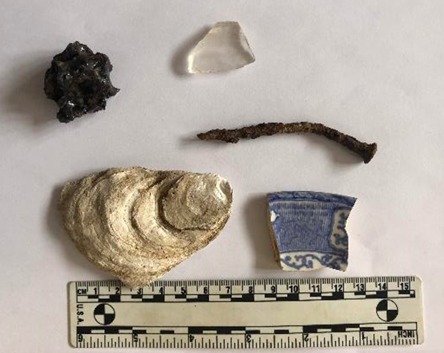At our annual preservation micro-grant event in October, Baltimore Heritage gave archaeologist Adam Fracchia $250 to help with his archaeological exploration of the lives of enslaved people and convict labor at the ruins of the former Northampton furnace iron foundry (near Hampton Mansion). The project has already yielded many fascinating results! Please enjoy our guest blog post by Dr. Fracchia (fracchia@umd.edu) below.
In December of 2019, the first season of the Northampton Furnace Archaeology Project came to a successful conclusion. The Project’s goals were to better understand and document the lives of the convicts, indentured servants, and the enslaved peoples forced to work at the iron furnace operated by the Ridgley family from 1762 to the late 1820s. The iron furnace, which produced pig iron and cast iron including cannons and shot used in the Revolutionary War, generated the Ridgley’s great wealth and supported their lavish lifestyle.
The archaeological field school operated through the University of Delaware, Newark, sought to find material evidence of their lives that would add these workers to the history and narrative of the Hampton plantation. Starting in August, the students and I began a field survey of the furnace landscape. They documented and mapped different features on this industrial landscape such as the earthen dam, quarries, the furnace, outbuildings, and structures.
Through the excavation of shovel test pits, the students surveyed a large area where workers were believed to have lived. Five test units were also excavated around the remains of a structure that may have dated to the period of the furnace. The students were able to document these structures below the surface and map and describe the different soil strata that detail the history of the site. Some artifacts were found dating to the furnace period. Evidence was also found of the farm that post-dated the furnace and was in operation until the flooding and creation of the Loch Raven Reservoir in the early twentieth century.
The students presented their preliminary findings to the public at Hampton NHS in December and the analysis of the archaeological data is currently ongoing. Much of the landscape of the furnace is buried or hidden under the later farm or is more ephemeral. The Project seeks an external contractor to conduct a higher resolution LIDAR scan of the core furnace area. This detailed scan of the elevation would allow us to better locate structures, such as the log houses, where the workers may have been living. This project is just the beginning of an effort to detail the lives of the workers at the furnace. We sincerely thank Baltimore Heritage for their support and encouragement with this project.
For more information, check out the project’s blog!

